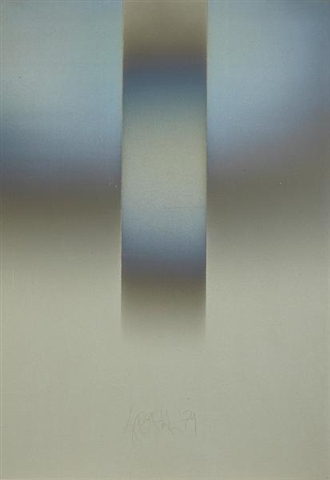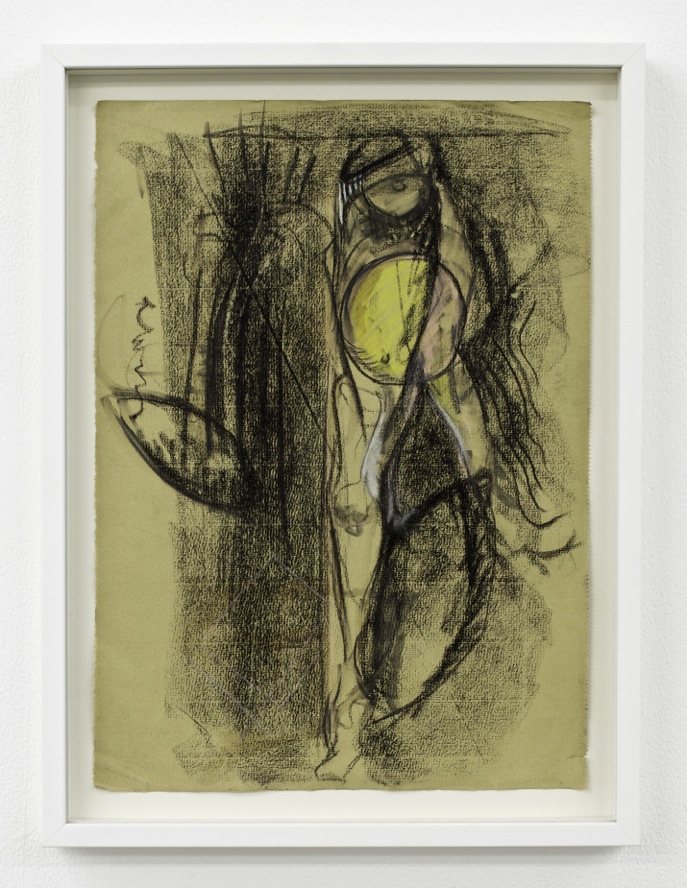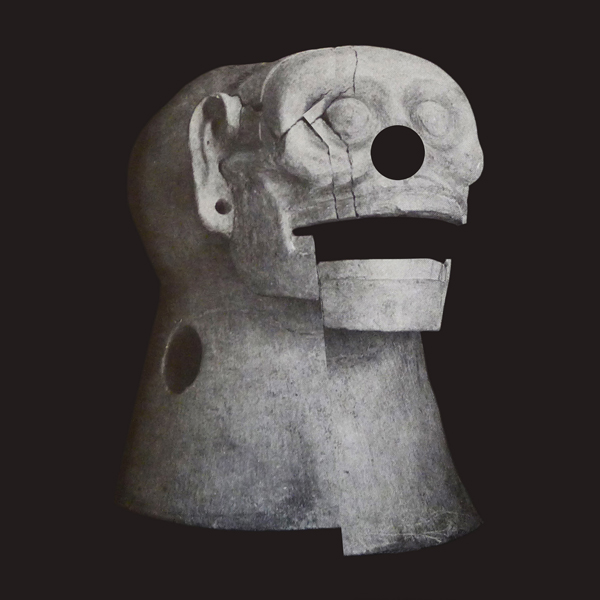
© » KADIST
Anna-Bella Papp
Untitled exemplifies the format that Anna Bella-Papp most commonly works in, using her hands to create delicate tablet-like reliefs within a rectangular form made out of clay. The lack of any glazes and other finishes used in traditionally in ceramics is a deliberate decision with an aim to preserve the pale hues and natural qualities of the clay. Papp’s decision to display the pieces resting flat on table tops, invites us to imagine them as landscapes or architectural structures seen from a bird’s-eye view.

© » KADIST
Anna Boghiguian
In the painting called “The Consciousness of Memory, Time, and Guilt” as in many of her recent works, the body is fragmented. The brain, the ear, the eyes, these body parts that put us in relation with the other and link the visible to the invisible, remain isolated. Whereas the skulls are joined by lines evoking rivers.

© » KADIST
Richard Bell
For Richard Bell, art is not simply a vehicle through which to represent and convey political content. On one hand, art itself has an activist charge—in its very form and presence it can shake up conventional or assumed understandings, opinions, and behaviours. But on the other hand, it is deeply implicated in the actions and attitudes associated with colonialism in Australia and abroad.

© » KADIST
Anna Molska
Perspective was filmed during a residence in northern Poland. The film is preceded by a series of photographs made ? ?in her studio.
![Diálogo [Dialogue]](https://kadist.org/wp-content/uploads/2023/10/Dialogo-1-scaled.jpg)
© » KADIST
Patricia Belli
In the mid-1990s, Belli started to create soft sculptures that allowed her to reconnect with manual labor and sewing learned from her seamstress mother. Using recycled fabrics and objects collected from friends and second-hand stores in Nicaragua, Belli’s work explored the codification of family space—using dolls, tables, tablecloths, and curtains—making tangible how masculine authority is inscribed onto women’s bodies daily. Produced during her time as an MFA student at the San Francisco Art Institute, Diálogo is part of a group of sculptures that addresses the tension between restriction and agency, imprisonment and liberation, and ultimately, the possibilities and limits of human action in a society with deeply eroded democratic structures.

© » KADIST
Anne Samat
Anne Samat’s Puteri 3 references Ulek Mayang, a classical Malay dance, performed in a ritualistic pre-Islamic context. It is based on the myth of a princess from the sea who steals the soul of a fisherman she falls in love with, leaving his body lifeless. A battle ensues for the soul of the fisherman, between a shaman (bomoh) trying to bring back the spirit into the earthly flesh and the princess aided by five of her sisters.

© » KADIST
Jumana Manna
Blue Elbow (Coude bleu) is made from plaster, burlap, lacquer, pigments and plastics. The materials related to the techniques of the sculpture or the painting but also others, which refer to commerce, to objects of consumption. The chair refers directly to the body as does the title of the work, Blue Elbow .

© » KADIST
Larry Bell
Untitled (Construction) recalls the series of glass cubes that gained Bell international recognition in the 1960s. Resembling a black-mirrored box, this recent iridescent piece produces an uncanny effect in which the interior planes seem to enclose a mysterious light. Although austere in form, Bell’s works are far from simple: he uses technology like a vacuum-coating process, to accurately control the different levels of opacity and transparency on the surface of his immaculate glass works.

© » KADIST
Larry Bell
Drawing & Print (Drawing & Print)
Like many of Larry Bell’s works, VFGY9 deals primarily with the viewer’s experience of sight. The blocks resemble a stone carving, or slabs of wood shaped into a simple organic composition whose overall sheen is varied through a thin layer of aluminum vapor. Yet, the real material of Bell’s piece is actually light, formed within the viewer’s eye into masses as present as stone.

© » KADIST
Papa Ibra Tall
During the years of President Senghor, Papa Ibra Tall was influential in the cultural dimension of Senegalese politics, participating in the implementation of the Dakar School, a movement of artistic renewal born at the dawn of the country’s independence between 1960 and 1974 and which was encouraged by President Senghor. The artist set out to transcribe ‘negritude’ in his works, according to Senghor’s definition in Problème de la Négritude: “To assume the values of civilization of the Black world, to actualize them and to fertilize them, if necessary with the foreign contributions, to live by oneself and for oneself, but also to make them live by and for others, thus bringing the contribution of the new Negroes to the civilization of the universal.”

© » KADIST
Ana Vaz
Há Terra! (There Is Land!) is a short film by Ana Vaz that picks up on the artist’s previous film A Idade da Pedra (2013), in which Vaz imagined premodernity in her native Brazil.

© » KADIST
Anne Imhof
Drawing & Print (Drawing & Print)
“School of the seven Bells (SOTSB)” is based on a series of hands games in which an object is passed from hand to hand. The performance is a reference to the film by Robert Bresson, “Pickpocket”, where a group of pickpocketers play with their victims. The artwork, through the actions of the hands, is an interrogation into space and time, questioning the relationship between public and private space, the establishment of communication through the body and visual exchange and gestures between aggression and sensuality.

© » KADIST
Anne Imhof
Anne Imhof’s video work Untitled (Wave) creates resonances between the feminine, adoration, and immateriality, while also referring to the history of art and aesthetics, in particular the concept of the sublime. Starring Imhof’s partner and collaborator Eliza Douglas, the film depicts a woman, naked from the waist up, dressed simply in tracksuit trousers, long black hair, feet dipped in the ocean water. The woman bears a long whip, while she looks out at the horizon and the waves lick at her bare feet.

© » KADIST
Mary Ann Aitken
Untitled (Boom Box, Double-Sided) by Mary Ann Aitken is representational painting of a boom box on an unconventionally long canvas painted on both sides, to mimic the scale and appearance of the actual appliance. Known for going against trends, Aitken often favored dimensions, such as the square, that were otherwise considered out of style in contemporary painting. In this double-sided painting, one side depicts the titular boombox set up—a boxy cassette player, flanked by a pair of stereo speakers in front of wood panelling.

© » KADIST
Jordan Ann Craig
Something To Do With Being Held by Jordan Ann Craig is inspired by a Cheyenne bead bag. Intrigued by the two shades of blue used for the source object (a deep dusty blue and a bold vivid cobalt blue) the artist replicated these shades in her painting. Craig then added in her own colors, including the pink-orange hues, to achieve a bold but soft quality about the work, as she states that she intended the work to convey vulnerability.

© » KADIST
Mary Ann Aitken
Untitled (Diptych) by Mary Ann Aitken is a pair of paintings; one entirely abstract and the other a hybrid of representational and abstract elements. The left-side painting is a cacaphonous all over composition of brushstrokes layered in the artist’s signature primary colors. In the same color scheme, the right-side painting portrays a still life with an arrangement of flowers as its focal point, with marks and splatter spilling from the left-side composition into the right.

© » KADIST
Ana Vaz
Ana Vaz describes her film É Noite na América (It is Night in America) as an eco-terror tale, freely inspired by A cosmopolitics of animals by Brazilian philosopher Juliana Fausto; in which she investigates the political life of non-human beings and questions the modern idea of the exceptionality of the human species. In parallel to the feature film version, Vaz created a three-channel installation format meant to be displayed in contemporary art spaces. This edition includes three complementary video works that expand on the conceptual frameworks of the film.

© » KADIST
Ana Navas
Ana Navas uses humor to address formal, aesthetic, and societal conventions that are interwoven in the everyday through the normalization of gendered behaviors and style choices used to project personal and collective signifiers. In her Donation Vases she uses quotes taken from corporate coach Lois P. Frankel’s book Nice girls (still) don’t get the corner office: Unconscious Mistakes Women Make That Sabotage Their Careers (2004). The aspirational, somewhat cynical tone of the sentences – “When given a choice, sit next to most powerful person, their power will cascade over you,” “Why is it that women buy those little chains to hang reading glasses around their necks,” “If you see your reflection on a glossy surface & notice something wrong, avoid fixing it there” – reveals a particular understanding of what a professional, ambitious cis woman should look like, the persona she should project, and the type of desirable behaviors that constitute a stereotypical “successful woman” according to a capitalist morality.

© » KADIST
Ana Roldán
Ana Roldán’s Primeval forms series looks up close at the fecund shapes of plants often found in the artist’s native Mexico. These botanical portraits, like this one of the Pseudobombax ellipticum, or shaving brush tree, bristle against the edges of the image’s frame, fecund and wild, familiar yet foreign. Ana Roldán works in diverse media such as performance, sculpture, installations, video and collage.

© » KADIST
Ana Roldán
Ana Roldán’s Displacements works use images taken from a 1970s exhibition catalogue for an exhibition called The Death in Mexico. Using pre-Columbian objects and other artifacts from Mexican history, the exhibition aimed to explore various representations of death in the Mexican cultural tradition. Roldán’s works begin with these rich black-and-white photographs and break them apart into fragments, slicing and dismembering the artifacts they depict.
![Elevación [Elevation]](https://kadist.org/wp-content/uploads/2022/09/IMG_escena001_3513-scaled.jpg)
© » KADIST
Ana María Millán
Interested in role-play and videogames, Ana María Millán developed workshops with different communities in order to create characters and scenarios for her animations, often in collaboration with a choreographer. Elevación evokes various narratives inspired by the comicstrip Marquetalia, Raíces de la Resistencia (Marquetalia, Roots of the Resistance) (2011). This comic strip is a memoir of the FARC (Revolutionary Armed Forces of Colombia) guerillas written by Jesús Santrich, one of its leaders who, after the 2016 Peace Agreement, rejoined dissident members of the organization in a clandestine guerrilla splinter group in 2019.

© » KADIST
Ana Teresa Fernández
Drawing & Print (Drawing & Print)
The artist writes about her work Borrando la Frontera, a performance done at Tijuana/San Diego border: “I visually erased the train rails that serve as a divider between the US and Mexico. I painted them sky blue, creating a “Hole in the Wall” This deconstruction of “feminized” work explores the difficulties in reconciling both low wages and undervalued work via social and political infrastructures, confronting issues of labor and power. The images that I myself perform, present a duality: women dressed in a black tango dance attire while engaging in de-skilled domestic chores; the surreal within non-fiction.
Ana Vaz
Ana Vaz is an artist and filmmaker whose works speculate on the relationships between self and other, and myth and history, through a cosmology of signs, references, and perspectives...
Mary Ann Aitken
Mary Ann Aitken was known to be very private about her art practice; she was considered somewhat of an outsider by her peers affiliated with the second wave of Detroit’s Cass Corridor arts movement...
Larry Bell
- location: Venice, California
- year born: 1939
- gender: male
- nationality: American
- home town: Chicago, Illinois
Patricia Belli
Since the 1980s, Patricia Belli has been a driving force behind the rise of experimental work in Nicaragua...
Papa Ibra Tall
A crucial figure in the history of African modernism, Papa Ibra Tall was a renowned tapestry weaver, painter, and illustrator...
Richard Bell
Richard Bell works across a variety of media including painting, installation, performance and video and text to pose provocative, complex, and humorous challenges to our preconceived ideas of Aboriginal art, as well as addressing contemporary debates around identity, place, and politics...
Anna Boghiguian
Anna Boghighian makes drawings and paintings of individuals and urban spaces as well as being a writer and a poet...
Jordan Ann Craig
Jordan Ann Craig is a Northern Cheyenne artist born and raised in the Bay Area; she invests her work with a strong interest in Indigenous culture and the history of its destruction by settlers...
Anna-Bella Papp
Anna Bella-Papp recalls how intuitive it felt the first time she modelled something out of clay as a child...
Anna Molska
Anna Molska uses video performance to explore the effect of artistic culture on the production of art...
Anne Samat
An exuberant and precise sculptor, Anne Samat blends the aesthetic of international queer cultures – which she proudly represents as a transgender activist – with various textile and bricolage influences from South East Asia and beyond...
Jumana Manna
Jumana Manna is a Berlin-based artist whose work revolves around the body, national identity, and historical narratives...
Ana Navas
Ana Navas’s practice deals with the vulgarization of modern art, understanding the term vulgar in its original sense of being appropriated by common people...

© » LARRY'S LIST
about 14 months ago (03/01/2023)
CIRCA collaborates with Anne Imhof to present #YOUTH24 - a 24-hour print fundraiser...
-
1970-1979
Larry Bell
Drawing & Print
1979(Drawing & Print) Like many of Larry Bell’s works, VFGY9 deals primarily with the viewer’s experience of sight...
-
2000-2009
Patricia Belli
2000In the mid-1990s, Belli started to create soft sculptures that allowed her to reconnect with manual labor and sewing learned from her seamstress mother...
Mary Ann Aitken
2002Untitled (Boom Box, Double-Sided) by Mary Ann Aitken is representational painting of a boom box on an unconventionally long canvas painted on both sides, to mimic the scale and appearance of the actual appliance...
Larry Bell
2007Untitled (Construction) recalls the series of glass cubes that gained Bell international recognition in the 1960s...
Mary Ann Aitken
2009Untitled (Diptych) by Mary Ann Aitken is a pair of paintings; one entirely abstract and the other a hybrid of representational and abstract elements...
-
2010-2019
Ana Teresa Fernández
Drawing & Print
2011(Drawing & Print) The artist writes about her work Borrando la Frontera, a performance done at Tijuana/San Diego border: “I visually erased the train rails that serve as a divider between the US and Mexico...
Ana Roldán
2012Ana Roldán’s Primeval forms series looks up close at the fecund shapes of plants often found in the artist’s native Mexico...
Ana Roldán
2012Ana Roldán’s Displacements works use images taken from a 1970s exhibition catalogue for an exhibition called The Death in Mexico...
Anna-Bella Papp
2013Untitled exemplifies the format that Anna Bella-Papp most commonly works in, using her hands to create delicate tablet-like reliefs within a rectangular form made out of clay...
Anne Imhof
Drawing & Print
2013(Drawing & Print) “School of the seven Bells (SOTSB)” is based on a series of hands games in which an object is passed from hand to hand...
Anna Boghiguian
2014In the painting called “The Consciousness of Memory, Time, and Guilt” as in many of her recent works, the body is fragmented...
Jumana Manna
2015Blue Elbow (Coude bleu) is made from plaster, burlap, lacquer, pigments and plastics...
Anne Samat
2018Anne Samat’s Puteri 3 references Ulek Mayang, a classical Malay dance, performed in a ritualistic pre-Islamic context...
Jordan Ann Craig
2019Something To Do With Being Held by Jordan Ann Craig is inspired by a Cheyenne bead bag...
Ana María Millán
2019Interested in role-play and videogames, Ana María Millán developed workshops with different communities in order to create characters and scenarios for her animations, often in collaboration with a choreographer...
-
2020-2029
Anne Imhof
2021Anne Imhof’s video work Untitled (Wave) creates resonances between the feminine, adoration, and immateriality, while also referring to the history of art and aesthetics, in particular the concept of the sublime...
Richard Bell
2022For Richard Bell, art is not simply a vehicle through which to represent and convey political content...
Ana Vaz
2022Ana Vaz describes her film É Noite na América (It is Night in America) as an eco-terror tale, freely inspired by A cosmopolitics of animals by Brazilian philosopher Juliana Fausto; in which she investigates the political life of non-human beings and questions the modern idea of the exceptionality of the human species...